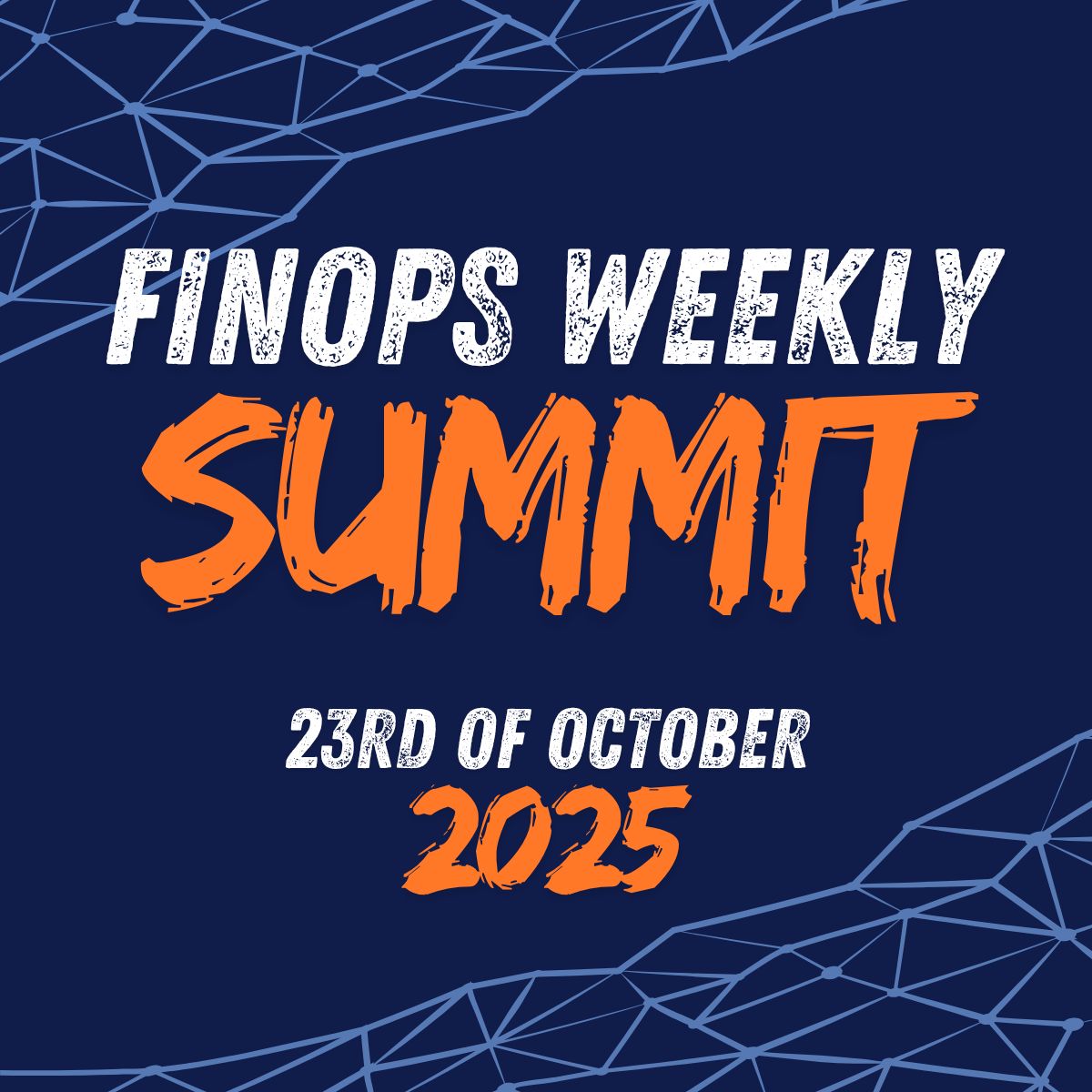Together with FinOps Weekly Summit
See You in The Largest Online FinOps Event
FinOps Weekly Summit 2025 is the one online event this year designed to give you the actionable playbooks you need to transform your FinOps practice.
Move from reactive fire-fighting to strategic leadership by learning directly from the world’s top experts on unit economics, automation, and governance.
Start Driving Business Value.
Stop Chasing Cloud Costs.
Don’t get left behind.
ENTERPRISE
Figma's AWS Bill is Not That High
The internet went wild this week when Figma's public filing showed they signed a $550 million contract with AWS over five years. People did some quick math and figured out that's about $300,000 per day on cloud services. Suddenly, everyone became an expert on cloud costs and started saying Figma was doomed.
Figma spends roughly $109 million per year on AWS, which is about 12% of their $821 million in revenue. They serve 13 million monthly users and 450,000 paying customers while keeping a 91% profit margin. That's actually pretty normal for a company that runs complex, real-time design software.
Industry standards show that simple software companies spend about 5% of revenue on cloud costs, while heavy-duty platforms like Figma typically spend 10-15%. Companies using lots of AI can spend even more. Figma's 12% fits right in the normal range.
Other big companies spend way more. Snowflake has a $2.5 billion cloud commitment. Apple was spending $360 million annually back in 2019. Snap once committed to $3 billion in cloud spending and had to renegotiate because it was too much.
Figma is actually doing smart things to control costs. They switched from Ruby to C++ for better performance. They moved workloads away from expensive GPU servers when possible. They use smart scaling to match their server capacity to actual demand.
The real story isn't that Figma spends too much on AWS. It's that they were honest enough to share the numbers when most companies hide their infrastructure costs.
AWS
Automate AWS Budget Management with Email Alerts
Managing AWS costs across multiple accounts can be tricky, but AWS has created a smart solution that makes budget control much easier. Here's how the system works:
The finance team puts budget amounts for each account into a special database table. When they update these numbers, it triggers an automatic process that sends the new budget limits to each individual account. Each account then updates its own spending tracker with the new limit.
If an account starts spending too much money, the system automatically sends email alerts to the right people. This happens without anyone having to manually check each account every day.
The setup uses several AWS tools working together. The main account stores all the budget information in DynamoDB. A Lambda function watches for changes and pushes updates to other accounts through Systems Manager. Each account uses AWS Budgets to track its actual spending and send notifications when limits are reached.
FINOPS EVENTS
Automating Cost Analysis with MCP
Use the Most Powerful AI Protocol for Your FinOps Practice
Learn how to use natural language to explore your organization’s cloud costs via MCP clients, like Claude, Cursor, and others. All explained in 1 Hour.
Hosted by industry leaders Victor Garcia (Founder, FinOps Weekly), Ben Schaechter (CEO & Co-Founder, Vantage). Seats for this live event are limited.
17th July - 6:00 PM CEST / 12 PM EST
FINOPS FOUNDATION
FinOps Executive Decisions
FinOps teams are moving beyond just watching cloud costs. They're now helping company leaders make big money decisions about all kinds of technology spending.
The FinOps Foundation brought together top executives in FinOps X San Diego to talk about how they use FinOps for major business choices. These leaders shared what works best when connecting technology spending to company goals.
Actions Leaders Can Take Now:
Find an executive who will champion FinOps as a way to move faster and find new opportunities, not just control costs.
Move FinOps teams from giving advice to actually participating in major platform and vendor decisions.
Create standard ways to evaluate investment choices using data instead of gut feelings.
Make sure all technology spending data follows the same format and has proper labels so it can be trusted for decisions.
Train teams across the company in FinOps thinking so everyone understands how spending connects to results.
Companies are shifting from asking "What does this cost?" to "What value does this decision create?" FinOps helps bridge the gap between technology investments and business results in our complex technology world.
CLOUD PROVIDERS
Some new Instances and Network Cost Changes
AWS
AWS Amazon Connect now supports parallel AWS Lambda functions within contact flows, eliminating wait times between functions. This speeds up call flows, reducing customer wait times and operational costs.
AWS launched P6e instances featuring NVIDIA GB200 Grace Blackwell Superchips for demanding AI/ML training. These top-tier instances promise significant performance improvements, potentially offering better cost-efficiency through faster model training.
QuickSight gained enhanced export controls, allowing granular customization of data visibility and export permissions. This improves data governance while ensuring users only access relevant cost data and metrics.
AWS Config added support for 12 new resource types, including Amazon Bedrock agents and AppSync. Enhanced configuration tracking improves security and helps FinOps teams understand infrastructure changes.
Microsoft Azure
Azure Budgets now support evaluation at subscription scope within management groups. This enables single budget setup at management group level with alerts triggered by individual subscription spending - perfect for granular cost control in large organizations.
AZURE
Azure SQL DTU Model: Overbilling +24 Hours a Day
A FinOps consultant found something strange while checking Azure SQL database bills. Some databases were being charged for more than 24 hours in a single day, even though a day only has 24 hours.
Azure SQL databases use DTU pricing. DTU stands for Database Transaction Unit. It bundles CPU, memory, and storage into one simple package. You pick a tier like S4 or S7, and pay by the hour.
The problem starts when you change tiers during the same day. Let's say you start with S4 in the morning, then switch to S7 at noon, then back to S4 in the evening. Azure treats each tier change as a separate billing event.
This happens because Azure doesn't round up to full hours like it does with virtual machines. Instead, it calculates exact fractional hours for each tier, then adds them all together.
To fix this issue, you can switch to vCore pricing instead of DTU. vCore bills by the second and is more transparent. But be careful - vCore charges extra for storage, while DTU includes storage in the price.
📺 VIDEO
Start in FinOps in < 30 Minutes
I've joined all the FinOps Weekly editions in a single place and generated one of the most concise introduction to FinOps resources.
🎖️ MENTION OF HONOUR
Logs Don’t Lie
Erik Norman points out a big problem that many companies face but rarely talk about:
Cloud providers like Amazon, Microsoft, and Google don't help you automatically delete old logs when they're no longer needed. Instead, they just send you a bill that keeps getting bigger each month.
The real issue is that most teams don't know what to do with their logs. When asked why they keep certain logs or what they use them for, the common answer is "I don't know." This leads to paying for storage of data that might be completely useless.
Some logs are important for security and fixing problems. But many logs from systems like Kubernetes can cost a lot of money without providing much value.
Professional Spotlight
Dima Beliaev
FinOps Happiness
My man. He’s probably one of the nicest persons I found in this community. It was a pleasure to meet him along with Attribute team in Barcelona. Great to have people open to share and chat with a smile in the community.
That’s all for this week. See you next Sunday!
Join The Largest FinOps Online Event of 2025
Join FinOps professionals at the FinOps Weekly Summit 2025 and discover how to:
Transform from reactive fire-fighting to strategic leadership — Learn the proven frameworks that top practitioners use to turn cloud cost management into a competitive advantage
Master AI-powered cost optimization — Get exclusive access to the latest automation tools and techniques that can reduce your cloud spend by up to 40% while accelerating innovation
Build bulletproof unit economics — Walk away with actionable playbooks for calculating true cloud ROI and proving business value to executives who control your budget
"But I don't have time for another webinar..."
This isn't another generic webinar. This is the only major FinOps event left in 2025, featuring battle-tested strategies from companies managing billions in cloud spend.
October 23rd, 2025 | 4:00 PM - 8:00 PM CEST
Limited seats available










